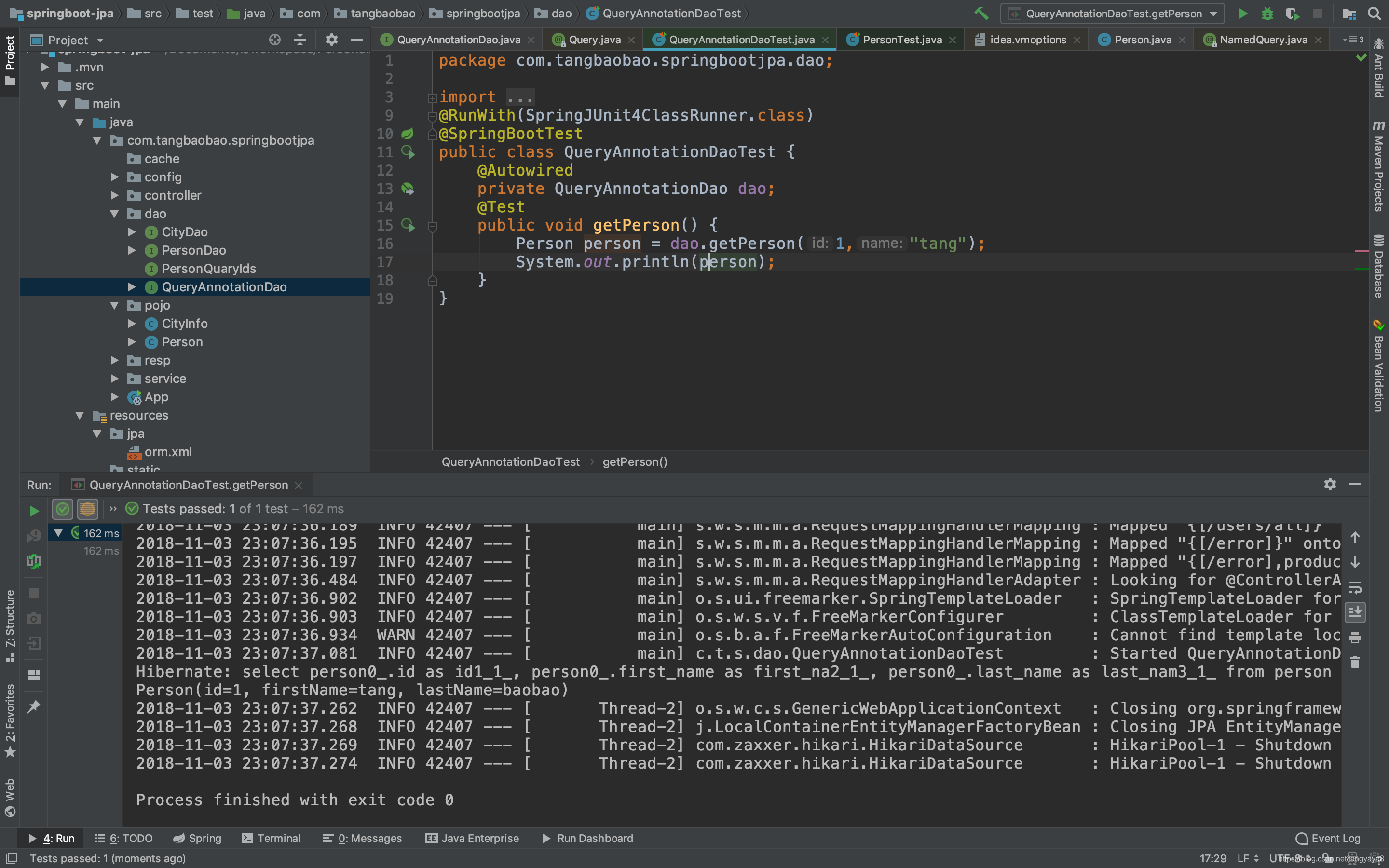Named-Query
就是在Entity上定义相关的查询方法,然后在Session中查询的时候,可以调用这个方法,实现相关的查询
XML方式
Person类:
package com.tangbaobao.springbootjpa.pojo;
import lombok.Data;
import javax.persistence.Entity;
import javax.persistence.Id;
import javax.persistence.NamedQuery;
/**
* @author tangxuejun
* @version 2018/10/28 11:39 PM
*/
@Data
@Entity
public class Person {
@Id
private Integer id;
private String firstName;
private String lastName;
}
orm.xml
<?xml version="1.0" encoding="UTF-8"?>
<entity-mappings xmlns="http://java.sun.com/xml/ns/persistence/orm"
xmlns:xsi="http://www.w3.org/2001/XMLSchema-instance"
xsi:schemaLocation="
http://java.sun.com/xml/ns/persistence/orm
http://java.sun.com/xml/ns/persistence/orm_1_0.xsd"
version="1.0">
<package>com.tangbaobao.springbootjpa.pojo</package>
<entity class="Person">
<named-query name="person">
<query>select p FROM Person p</query>
</named-query>
</entity>
</entity-mappings>
注解
在Entity上编写响应的HQL
package com.tangbaobao.springbootjpa.pojo;
import lombok.Data;
import javax.persistence.Entity;
import javax.persistence.Id;
import javax.persistence.NamedQuery;
/**
* @author tangxuejun
* @version 2018/10/28 11:39 PM
*/
@Data
@Entity
@NamedQuery(name = "Person.findPerson",
query = "SELECT p FROM Person p WHERE p.id=?1")
public class Person {
@Id
private Integer id;
private String firstName;
private String lastName;
}
编写接口(如果不用SpringBoot-jpa,可以用传统的Session来实现)
package com.tangbaobao.springbootjpa.dao;
import com.tangbaobao.springbootjpa.pojo.Person;
import org.springframework.data.jpa.repository.JpaRepository;
import org.springframework.stereotype.Component;
import java.util.List;
@Component
public interface QueryAnnotationDao extends JpaRepository<Person, Integer> {
List<Person> findPerson(int id);
}
编写测试类:
package com.tangbaobao.springbootjpa.pojo;
import com.tangbaobao.springbootjpa.dao.QueryAnnotationDao;
import org.junit.Test;
import org.junit.runner.RunWith;
import org.springframework.beans.factory.annotation.Autowired;
import org.springframework.boot.test.context.SpringBootTest;
import org.springframework.test.context.junit4.SpringJUnit4ClassRunner;
import static org.junit.Assert.*;
@SpringBootTest
@RunWith(SpringJUnit4ClassRunner.class)
public class PersonTest {
@Autowired
private QueryAnnotationDao dao;
@Test
public void getFirstName() {
System.out.println(dao.findPerson(1));
}
}
上面的查询会在Person 类上加入一些注解,称之为侵入式设计,并且把SQL语句写在类上,总感觉有点别扭,可能是我没有领会到JPA的强大之处吧.
@Query 查询
Using named queries to declare queries for entities is a valid approach and works fine for a small number of queries. As the queries themselves are tied to the Java method that executes them, you can actually bind them directly by using the Spring Data JPA @Query annotation rather than annotating them to the domain class. This frees the domain class from persistence specific information and co-locates the query to the repository interface.
@Query适用于少量的查询,这种方式不会直接将查询HQL放在类上,更加简洁。
package com.tangbaobao.springbootjpa.dao;
import com.tangbaobao.springbootjpa.pojo.Person;
import org.springframework.data.jpa.repository.JpaRepository;
import org.springframework.data.jpa.repository.Query;
import org.springframework.stereotype.Component;
@Component
public interface QueryAnnotationDao extends JpaRepository<Person, Integer> {
@Query(value = "SELECT p FROM Person p WHERE p.id = ?1 AND p.firstName = ?2")
Person getPerson(int id, String name);
}
@Query中?是一个占位符,后面跟的数字代表是方法中的第几个参数
这样就查出来了

@Query注解源码:
/*
* Copyright 2008-2016 the original author or authors.
*
* Licensed under the Apache License, Version 2.0 (the "License");
* you may not use this file except in compliance with the License.
* You may obtain a copy of the License at
*
* http://www.apache.org/licenses/LICENSE-2.0
*
* Unless required by applicable law or agreed to in writing, software
* distributed under the License is distributed on an "AS IS" BASIS,
* WITHOUT WARRANTIES OR CONDITIONS OF ANY KIND, either express or implied.
* See the License for the specific language governing permissions and
* limitations under the License.
*/
package org.springframework.data.jpa.repository;
import java.lang.annotation.Documented;
import java.lang.annotation.ElementType;
import java.lang.annotation.Retention;
import java.lang.annotation.RetentionPolicy;
import java.lang.annotation.Target;
import org.springframework.data.annotation.QueryAnnotation;
/**
* Annotation to declare finder queries directly on repository methods.
*
* @author Oliver Gierke
* @author Thomas Darimont
* @author Christoph Strobl
*/
@Retention(RetentionPolicy.RUNTIME)
@Target({ ElementType.METHOD, ElementType.ANNOTATION_TYPE })
@QueryAnnotation
@Documented
public @interface Query {
/**
* Defines the JPA query to be executed when the annotated method is called.
* 一般注解上都会有的字段,这个表示在调用这个被@Query修饰的方法的时候,会执行里边的HQL语句
*/
String value() default "";
/**
* Defines a special count query that shall be used for pagination queries to lookup the total number of elements for
* a page. If non is configured we will derive the count query from the method name.
* 用于查询分页参数的统计
*/
String countQuery() default "";
/**
* Defines the projection part of the count query that is generated for pagination. If neither {@link #countQuery()}
* not {@link #countProjection()} is configured we will derive the count query from the method name.
*
* @return
* @since 1.6
*/
String countProjection() default "";
/**
* Configures whether the given query is a native one. Defaults to {@literal false}.
*/
boolean nativeQuery() default false;
/**
* The named query to be used. If not defined, a {@link javax.persistence.NamedQuery} with name of
* {@code $ domainClass}.${queryMethodName}} will be used.
*/
String name() default "";
/**
* Returns the name of the {@link javax.persistence.NamedQuery} to be used to execute count queries when pagination is
* used. Will default to the named query name configured suffixed by {@code .count}.
*
* @see #name()
* @return
*/
String countName() default "";
}
不想用HQL查询,想用原生sql?(nativeQuery)
@Query 注解中也提供了对原生查询的支持,只需要在Query注解中加入一个属性就可以了:
@Query(value = "select * from person p where p.id =?1", nativeQuery = true)
//value 中是原生的SQL语法,不是基于对象操作的HQL语法
Person getPersonWithNative(int id);
想通过分页查询,并返回分页相应的值(countQuery)
SpringBoot -jpa简化了分页,在查询的时候,只需传入Pageable相应的参数,就可以返回一个Page,其中Page对象中包含了页数,总条数,以及查询的内容等。
代码演示:
package com.tangbaobao.springbootjpa.dao;
import com.tangbaobao.springbootjpa.pojo.Person;
import org.springframework.data.domain.Page;
import org.springframework.data.domain.PageRequest;
import org.springframework.data.domain.Pageable;
import org.springframework.data.jpa.repository.JpaRepository;
import org.springframework.data.jpa.repository.Query;
import org.springframework.stereotype.Component;
@Component
public interface QueryAnnotationDao extends JpaRepository<Person, Integer> {
@Query(value = "SELECT p FROM Person p WHERE p.id = ?1 AND p.firstName = ?2",
countQuery = "select count(p.id) from Person p")
Page<Person> getPerson(int id, String name, PageRequest pageRequest);
@Query(value = "select * from person p where p.id =?1",
countQuery = "select count(*) from person",
nativeQuery = true)
Page<Person> getPersonWithNative(int id, Pageable pageable);
}
运行结果:
